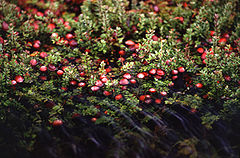
Back Fenberge ANG عنيبية حامضة Arabic عنبيه حادة الخباء ARZ Arándanu coloráu AST Mickekominan ATJ Mərcanı Azerbaijani مرجانی AZB Мүк еләге Bashkir Spongoulė BAT-SMG Журавіны Byelorussian
| Cranberries | |
|---|---|

| |
| Cranberry bush with fruit partially submerged in bog | |
| Scientific classification | |
| Kingdom: | Plantae |
| Clade: | Tracheophytes |
| Clade: | Angiosperms |
| Clade: | Eudicots |
| Clade: | Asterids |
| Order: | Ericales |
| Family: | Ericaceae |
| Genus: | Vaccinium |
| Subgenus: | Vaccinium subg. Oxycoccus (Hill) A.Gray |
| Species | |
|
Vaccinium erythrocarpum | |



Cranberries are a group of evergreen dwarf shrubs or trailing vines in the subgenus Oxycoccus of the genus Vaccinium. Cranberries are low, creeping shrubs or vines up to 2 meters (7 ft) long and 5 to 20 centimeters (2 to 8 in) in height; they have slender stems that are not thickly woody and have small evergreen leaves. The flowers are dark pink. The fruit is a berry that is larger than the leaves of the plant; it is initially light green, turning red when ripe. It is edible, but has an acidic taste.
In Britain, cranberry may refer to the native species Vaccinium oxycoccos,[1] while in North America, cranberry may refer to V. macrocarpon.[2] Vaccinium oxycoccos is cultivated in central and northern Europe, while V. macrocarpon is cultivated throughout the northern United States, Canada and Chile.[3] In some methods of classification, Oxycoccus is regarded as a genus in its own right.[4] Cranberries can be found in acidic bogs throughout the cooler regions of the Northern Hemisphere.
In 2020, the U.S., Canada, and Chile accounted for 97% of the world production of cranberries. Most cranberries are processed into products such as juice, sauce, jam, and sweetened dried cranberries, with the remainder sold fresh to consumers. Cranberry sauce is a traditional accompaniment to turkey at Christmas and Thanksgiving dinners in the U.S. and Canada, and at Christmas dinner in the United Kingdom.[5]
- ^ Cite error: The named reference
Stac10was invoked but never defined (see the help page). - ^ USDA, NRCS (n.d.). "Vaccinium macrocarpon". The PLANTS Database (plants.usda.gov). Greensboro, North Carolina: National Plant Data Team. Retrieved 11 November 2014.
- ^ "How Cranberries Grow: "Cranberries 101" – An Introduction". Cape Cod Cranberry Growers' Association. 2014. Archived from the original on 6 February 2015. Retrieved 11 November 2014.
- ^ Steven Clemants. "Vaccinium oxycoccos: Small Cranberry, Technical Page". Brooklyn Botanic Garden. Archived from the original on 23 August 2011. Retrieved 26 March 2011.
- ^ Carol Cloud Bailey (19 November 2009). "Garden Tips: Give thanks for cranberries, grown with a taste of Florida". TCPalm.com. Scripps Interactive Newspapers Group. Retrieved 20 November 2009.